Cyperus engelmannii (Engelmann's Flatsedge)
| Also known as: | |
|---|---|
| Genus: | Cyperus |
| Family: | Cyperaceae (Sedge) |
| Life cycle: | annual |
| Origin: | native |
| Habitat: | part shade, sun; wet sandy or muddy soil; shores, banks, marshes, mudflats, ditches |
| Fruiting season: | August - October |
| Plant height: | 4 to 24 inches |
| Wetland Indicator Status: | none |
| MN county distribution (click map to enlarge): |  |
| National distribution (click map to enlarge): |  |
Pick an image for a larger view. See the glossary for icon descriptions.
Detailed Information
Flower: 

![[photo of spikelet clusters]](/udata/r9ndp23q/pd3/cyperus-engelmannii-7443-3-t.jpg) 2 to 10 clusters up to 1 inch long at the tip of the stem, each cluster loosely to densely packed with 20 to 60 spikelets (flower clusters), sometimes more, the spikelets arranged bottle-brush fashion on all sides of the cluster stalk, widely spreading with those at the tip erect to ascending. Auxiliary clusters have stalks ½ to 3 inches long and 1 to 3+ clusters at the tip of a stalk, but the clusters are often all congested at the top of the stem. At the base of the group of clusters are 5 to 8 leaf-like bracts of varying lengths, flat to V-shaped in cross-section, 2 to 10 inches long, all spreading to ascending.
2 to 10 clusters up to 1 inch long at the tip of the stem, each cluster loosely to densely packed with 20 to 60 spikelets (flower clusters), sometimes more, the spikelets arranged bottle-brush fashion on all sides of the cluster stalk, widely spreading with those at the tip erect to ascending. Auxiliary clusters have stalks ½ to 3 inches long and 1 to 3+ clusters at the tip of a stalk, but the clusters are often all congested at the top of the stem. At the base of the group of clusters are 5 to 8 leaf-like bracts of varying lengths, flat to V-shaped in cross-section, 2 to 10 inches long, all spreading to ascending.
![[close-up of spikelets]](/udata/r9ndp23q/pd3/cyperus-engelmanii-15-1-6-t.jpg) Spikelets are slightly flattened, linear-oblong in outline, 8 to 25mm (1/3 to 1 inch) long, with 6 to 20 florets, each subtended by a scale. Florets have 3 stamens and a 3-parted style. Scales are 2.1 to 3mm long, brown to reddish-brown, lance to egg-shaped, 1 to 3-ribbed per side with a green midrib that is blunt or pointed at the tip. The scales are arranged on opposite sides of the central spikelet stalk (rachilla), appressed, and the tip of one scale not overlapping the base of the one above it on the same side. The rachilla is yellowish to reddish, somewhat shiny, winged and segmented between the scales.
Spikelets are slightly flattened, linear-oblong in outline, 8 to 25mm (1/3 to 1 inch) long, with 6 to 20 florets, each subtended by a scale. Florets have 3 stamens and a 3-parted style. Scales are 2.1 to 3mm long, brown to reddish-brown, lance to egg-shaped, 1 to 3-ribbed per side with a green midrib that is blunt or pointed at the tip. The scales are arranged on opposite sides of the central spikelet stalk (rachilla), appressed, and the tip of one scale not overlapping the base of the one above it on the same side. The rachilla is yellowish to reddish, somewhat shiny, winged and segmented between the scales.
Leaves and stems: 


![[photo of prostrate, maturing plant]](/udata/r9ndp23q/pd3/cyperus-engelmanii-7510-1-t.jpg) Leaves are few, basal and alternate but near the base, V or M-shaped in cross-section, up to 6mm wide, 2 to 12 inches long, longer or shorter than the stem. Basal sheaths are brown to whitish. Stems are single or multiple from the base, erect to prostrate, relatively stout, 3-sided, and smooth. Plants form loose to dense clumps.
Leaves are few, basal and alternate but near the base, V or M-shaped in cross-section, up to 6mm wide, 2 to 12 inches long, longer or shorter than the stem. Basal sheaths are brown to whitish. Stems are single or multiple from the base, erect to prostrate, relatively stout, 3-sided, and smooth. Plants form loose to dense clumps.
Fruit: 
![[photo of spikelet, scales and maturing achenes]](/udata/r9ndp23q/grass/cyperus-engelmanii-4-t.jpg) The spikelets break apart between florets when mature, the floral scales and achenes (seeds) dropping off along with the attached segment of rachilla, which is about as long as the achene, the rachilla wings wrapping around the achene opposite to it. Achenes are 1.5 to 2.2mm long, brown to reddish to blackish when mature, 3-sided, narrowly oblong-elliptic in outline, somewhat tapered at the base with a short stalk-like appendage (stipe), more rounded at the tip end.
The spikelets break apart between florets when mature, the floral scales and achenes (seeds) dropping off along with the attached segment of rachilla, which is about as long as the achene, the rachilla wings wrapping around the achene opposite to it. Achenes are 1.5 to 2.2mm long, brown to reddish to blackish when mature, 3-sided, narrowly oblong-elliptic in outline, somewhat tapered at the base with a short stalk-like appendage (stipe), more rounded at the tip end.
Notes:
Cyperus odoratus and Cyperus engelmannii (also known as C. odoratus var. engelmannii) are the only two species of Cyperus in Minnesota where the spikelets break apart between florets. Both are rather variable in appearance, from tall and robust to short and somewhat sprawling, this variability possibly due to environmental conditions. The achenes of C. englemannii are longer and more slender than those of C. odoratus, but the most distinctive difference between the two species is the arrangement of scales on the spikelet: scales of C. engelmannii do not overlap where those of C. odoratus do (see comparison photo below). The bottle-brush like clusters are similar to other Cyperus species, notably Cyperus erythrorhizos, Cyperus esculentus and Cyperus strigosus, all of which have spikelets that break off in their entirety at the base rather than between florets. C. erythrorhizos also has longer clusters with shorter spikelets that are typically more densely packed in the cluster, giving a more distinct cylindric shape, and has distinctive reddish roots. Cyperus esculentus is leafier than C. odoratus or C. engelmannii and produces tubers on its roots. C. strigosus has much larger scales, 3 to 4+mm long.
Note that the separation of C. odoratus and C. engelmannii is not universally accepted and not currently recognized in Minnesota. The distribution maps reflect that. We have chosen to follow Michigan Flora on this one.
Native Plant Nurseries, Restoration and Landscaping Services ↓
More photos
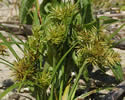 Cyperus engelmannii plant
Cyperus engelmannii plant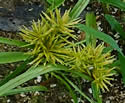 Cyperus engelmannii plants
Cyperus engelmannii plants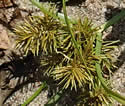 Cyperus engelmannii plants
Cyperus engelmannii plants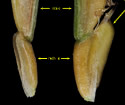 close-up of scale and rachilla
close-up of scale and rachilla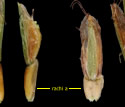 comparison of Cyperus engelmannii and Cyperus odoratus spikelets
comparison of Cyperus engelmannii and Cyperus odoratus spikelets
Photos by K. Chayka taken in Ramsey County. Photos courtesy Peter M. Dziuk taken in Itasca and Wilkin counties.
Comments
Have you seen this plant in Minnesota, or have any other comments about it?






